
Did you know that you are facing the biggest scam any Zimbabwean has ever endured? Yes, while you sit there, a scam much bigger in scale than the 2000-2008 heist when the government mafia plundered all national reserves, including pillaging private foreign accounts is in the works!
OPINION: Ken Yamamoto
For the avoidance of doubt, walk back in recent history and you will recall that ex-Reserve Bank of Zimbabwe (RBZ) governor Gideon Gono pillaged private foreign currency accounts. Remember the case I cited in my installment last year when a court ordered Standard Chartered Bank to pay back a Chinese company for foreign currency stolen by the RBZ? If you don’t recall the case of Standard Chartered Bank Zimbabwe Limited versus China Shougang International, read the details on http://bit.ly/2fdUabg. Eventually, the RBZ owed over a billion dollars due to such theft. The debt was taken to Zimbabwe’s Parliament, the details of who was owed and who owed what were kept private, and government took over the debt. But who is the government? Government is euphemism for the taxpayer. This means the RBZ stole money and you are paying for it — over and above, losing all your wealth due to the RBZ’s murder of the Zimbabwe dollar. This time, as was last time, the people scamming you are not Robin Hoods, who stole from the rich to give to the poor. They are gluttonous perennial grabbers fattening their pockets, knowing in your fear you can’t do nothing. They are worse that Pablo Escobar or El Chapo Guzman, who is languishing in jail in Mexico despite using some of his drug money for some local good.
Precipitating chaos
Economist Steve Hanke is known for his work on currencies — an advocate for currency boards. Known for having advised the Suharto’s government in Indonesia, Steve Hanke Sensei tracked the demise of the Zimbabwe dollar, also computing closer-to-reality hyper-inflation figures at a time Zimbabwe’s statistics agency was cooking up figures and eventually releasing none at all to hide the monster. Days ago, Steve Hanke Sensei remarked that: “I warned (deputy governor) Khupukile Mlambo of RBZ in May that Zimbabwe bond notes would create chaos. The RBZ is learning the meaning of chaos.” His point in my view is — by making that announcement on bond notes, RBZ governor John Mangudya precipitated chaos!
Remember that time when I said 2016 will be far worse — you can read that on http://bit.ly/22Gyzvt? What about that time when I wrote that Mangudya was a fencepost tortoise? http://bit.ly/2ecWSRw. A fencepost tortoise is described thus: when along a country road and you come across a fence post with a tortoise balanced on top, that’s called a fencepost tortoise. You know he didn’t get up there by himself, he definitely doesn’t belong up there, he doesn’t know what to do while he is up there, and you just have to wonder what kind of idiot put him up there in the first place.” The point I was making then was that the bond notes were not Mangudya’s idea. The truth of the matter is that Mangudya announced bond notes in May 2016 as a reaction to a serious cash shortage in Zimbabwe which saw depositors sleeping in bank queues and the government failing to pay salaries due in the same month. Fearing anarchy, Mugabe’s military-security people, commonly known as Joint Operations Command, went to Mangudya and said to him, if you made bond coins why don’t you make bond notes? This is why the Africa Export and Import Bank (Afreximbank) loan story appears to be a humbug, if not an outright falsehood.
Drip, drip bond coins, bond notes, then zero balances
President Robert Mugabe has proven that he is an ignoramus on managing an economy. He has had 36 years to prove it beyond any shadow of doubt. It took a few months for Mangudya to also prove that he is an ignoramus.
- Chamisa under fire over US$120K donation
- Mavhunga puts DeMbare into Chibuku quarterfinals
- Pension funds bet on Cabora Bassa oilfields
- Councils defy govt fire tender directive
Keep Reading
A few weeks after Mangudya’s announcement, I attended as a part of a private sector team at the 2016 Annual Meetings of the African Development Bank at the Mulungushi International Conference Centre in Lusaka, Zambia, held from May 23 to 27. I had occasion to ask a senior Afreximbank official on the issue of bond notes. He told me that the first time they learnt about bond notes was in the Press after Mangudya announced them. This means that at the point the announcement was made, the facility for bond notes didn’t exist. At that time, they were trying to panel-beat the idea by telling the government to tie it to exports. This probably explains why Mangudya kept kicking the can down the road — saying they would be introduced in August, then September, then October and now November! When consumers and companies started accepting bond coins for change, instead of rand coins or sweets, this emboldened the RBZ. It is important to note that when Zimbabwe adopted the US dollar, the RBZ became castrated and impotent. For years its officials have been fighting for relevance. So drip, drip, they are coming back into relevance at your expense. From being useless and heavily indebted, to issuing bond coins, and then bond notes in small denominations, and then bond notes in large value notes at which point they are asserting space over your savings. What happens when they have control, you all know!
Poking holes into the scam
Let’s poke some holes into the scam. In his own words from his monetary policy pronouncement, Mangudya says that the ceiling of the $200 million Afreximbank facility would be attained when total exports reach $6 billion. Now you don’t have to be a nuclear scientist or a National Aeronautics and Space Administration mathematician to figure out that this announcement is inherently crooked. Here is why: Mangudya says that the bond notes are issued as a 5% incentive on exports. This means that you receive five cents for every dollar of invoiced and exported goods. Now simple math will tell you that if they give five cents for every dollar exported up to $6bn, then Mangudya would need $300m which is $100m more than he claims to be getting from Afreximbank. Thus: 5⁄100 × $6 000 000 000 =$300 000 000 In other words: 5% incentive on $6 0000 000 000 ≠$200 000 000 Afreximbank loan
Put differently, only $4bn of exports would be sustained by a claim of a $200m loan from which five cents is given for every dollar of exports before that loan is exhausted.
What does this mean? It means Mangudya is right from the beginning planning to overprint the bond notes beyond the claimed loan, based on his assumptions. Now we know what happens when he does that. With that in mind, can you imagine what will happen when the bonus for civil servants that Finance minister Patrick Chinamasa had proposed to do away with, but was reversed by Mugabe, becomes due. By January next year, Zimbabwe’s civil servants will be threatening to strike like they did during the course of this year. Army generals will whisper in Mugabe’s ear that the strikes are a threat to national security, and the President and/or the generals will whisper into Mangudya’s ear that he must print more of those bond notes. Do you think Mangudya will say no? I don’t need to mention that when they issue you with bond notes, they are simultaneously taking away your genuine United States dollars along with its value. Unjust enrichment, isn’t it?
The parallel market will run amok
I have received a lot of information from Zimbabweans who follow my articles. One of them is the regulation issued by Mugabe as legal basis for the bond notes. Three striking issues are clear from this regulation. First, it doesn’t state that an independent board will be set-up to oversee transparency of their printing as per Mangudya’s monetary policy announcement. Second, it does not state the ties of the bond notes to an Afreximbank $200m loan. Third, it doesn’t state that the bond notes are an export incentive. Fourth, and most bizarre is Mugabe stating that the money he prints has the same value as the United States dollar.
The first three issues mean that Mangudya is not bound by regulations to limit bond notes issuance to the claimed loan, because the regulation under which they are issued does not recognise its existence. It also does not require him to set up an independent board to oversee their issuance. In effect, he can print an unrestricted quantity of bond notes and you cannot hold him to account. He is also not restricted to issuing these bond notes to exporters, is he? Since the exchange rate has been “cast in stone” by Mugabe, Mangudya is free to give you any quantity of bond notes while taking out your United States dollars at par. Perfect scam, isn’t it?
Questions that have been emailed to me indicate confusion on whether bond notes are a currency. It’s interesting how people get so wired up in definitions and start splitting hairs to the point of losing the meaning of it all.
Some smart genius calling himself Satoshi Nakamoto created a digital currency and named it Bitcoin. It’s legal tender in Japan, even though it’s not Japanese yen. Currently, it’s the most valuable currency based on its exchange rate to the United States dollar. So let’s cut through the muck. Are bond notes United States dollars? No.
Are they South African rand, Zambian kwacha, Nigerian naira or British pound? No. So, what are they? They are Zimbabwean money, printed by Mangudya’s RBZ. It is common sense that you can only decree an exchange rate, like Mugabe did, because it’s a Zimbabwean currency. In short, Zimbabwe is back to having its own currency — and has chosen to call it bond notes. The long and short of it — the Zimbabwe dollar is back in print, at Fidelity Printers, the RBZ’s printing firm.
Exchange rate is set, inherently
Assume you are an exporter, and you have exported $100 worth of chrome to China. China will pay you $100, and then the RBZ will pay you bond notes worth five dollars. Assume that Mangudya’s claim to have an Afreximbank loan is true, then it’s not the RBZ that’s paying the exporter — it’s the taxpayer.
Why? Because the RBZ cannot generate revenue to pay back that loan, which means that the “incentive” is a tax on citizens.
Assume the chrome exporter now wants to buy parts for a Komatsu excavator, which is made in Japan. He will have no use for the bond notes. He will have to sell them for US dollars. But the reason bond notes are there in the first place is a shortage of US dollars (not Mangudya’s explanation that he wants to prevent smuggling). The exporter holding the bond notes, will either wait for the RBZ to redeem his bond notes for real money or find an alternative. We know that the RBZ has a backlog of telegraphic transfers running back as far as May this year.
So, if the exporter still wants to be in business, they have to go on the parallel market to buy real US dollars, and voila, parallel trading at a market driven exchange rate starts – not at Mugabe’s decreed 1:1 exchange rate.
This is just one exporter. Do the math when there are multiple exporters x_1, x_2, x_3,…. x_n. That gives you grim reality!
The RBZ will be forced to print more bond notes with time. People will trade locally with bond notes while keeping the real dollars at home. This is how bad money drives good money out of the market. And before you know it — bond notes are active.
Mugabe has decreed an exchange rate of 1:1. Mugabe’s exchange rate is an admission that the bond note is not the US dollar, and cannot bear the same value. In essence, Mugabe is pegging the bond note value to the US dollar. Pegging currencies used to happen decades ago, but governments abandoned that in favour of a market-based floating systems due to market pressures, speculation and the development of thriving black markets.
But what is the real exchange rate of the bond note? In theory, currencies are more valuable whenever their demand is greater than the available supply, and vice-versa. The demand for a currency is driven by either its ability to store value, or increase in the level of transactions in that currency. This generally increases in line with a country’s productivity, employment levels and level of business activity. Theoretically, exchange rates are determined by the value of a country’s output.
By making it an export incentive, at 5% of the exports, Mangudya created a theoretical and inherent exchange rate of the bond note. As such, each one dollar export will earn you a five cents bond note. To earn a $1 bond note, you must export goods worth $20 calculated as — 100⁄5× 100=$20. The theoretical exchange rate is therefore: 1 Bond note = US$20 OR US$1 = 5 US cents
So, that is the theoretical starting point. Thereafter, the parallel market traders can push it as far as they want. And the exchange rate will run amok!
What should you do now?
The effect of this new currency is that the people issuing the currency — Mugabe and Mangudya — will suck out your US dollars and leave you holding bond notes. How they do so is clear from the explanation given above. If ever there is a time to show your government that you can resist plunder, it’s now!
So, you can choose to sit there and look for the silver lining or reject the scam. The truth is that the elite crooks and the parallel market dealers — a privileged few with guarded access to the Zimbabwe’s cake will get out of this much richer while everybody else is impoverished. The script is not new. The players remain the same. The light at the end of the tunnel you may be seeing is in fact a train coming to crush you. You don’t have to believe me or take my word for it. All you must just do is look at their record. They have done it before with no consequences and are doing it again!
Ken Yamamoto is a research fellow on Africa at an Institute in Tokyo. He researches and travels frequently in Uganda, Kenya, Rwanda and Zimbabwe. Hiroshi Komatsu contributed in this article. Email your views to [email protected]











